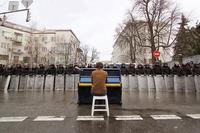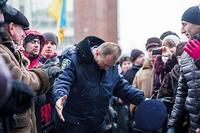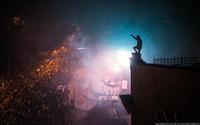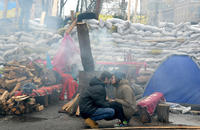Overview
#Euromaidan (#Євромайдан) refers to an ongoing series of protests in Ukraine that started in late November 2013 in response to the government’s suspension of signing diplomatic and trade agreements towards closer integration with the European Union.
Background
The civil unrest in Ukraine began on the night of November 21st, 2013, when a large-scale protest erupted across the capital city of Kiev shortly after President Viktor Yanukovych announced the suspension of finalizing diplomatic and trade agreements with the European Union (EU), in favor of protecting its long-standing relations with the Commonwealth of Independent States (CIS), a regional organization consisting of former Soviet republics under the political influence of Russia. The decision, which came after months of fast-tracking political reforms to meet the EU standards and consequent decline in trade relations with Russia, was immediately met by from those who sought a closer European integration.
Notable Developments
Mobilization
In reacting to the news, the opposition party leader Arseniy Yatsenyuk called for a protest to be held that same night via Twitter, asking people to gather at Maidan Nezalezhnosti (Independence Square) with the hashtag #Euromaidan. As the bulletin quickly spread throughout Ukrainian social networks and blogs, #Euromaidan became adopted as the banner of the pro-EU movement.
Усі на #Євромайдан! Янукович не розуміє іншої мови, окрім Майдану. Тож маємо показати, що влада – це МИ! Приєднуйтеся http://t.co/Rf0AS4Lcje
— Arseniy Yatsenyuk (@Yatsenyuk_AP) November 21, 2013
Street Protests
Euromaidan began as a peaceful assembly of 2,000 protesters at Kiev’s Maidan Nezalezhnosti (Independence Square), however, by the third night of the protest, the number had grown to tens of thousands and as high as 200,000 by some reports. On the night of November 24th, police used tear gas to disperse a small group of protesters attempting to storm the Cabinet of Ministers building. According to the officials, 200 protesters and police were injured as a result of the clash.
Occupation
Many refused to leave the Independence Square until the EU agreements were signed and a makeshift fortified camp was set up on-site in downtown Kiev. By the end of November, many university students and groups had joined the protests and a formal resolution was drafted and posted online:
1. Form a coordinating committee to communicate with the European community.
2. Call for Yanukovych’s resignation from his office, as the president, parliament and the Cabinet of Ministers aren’t capable of carrying out a geopolitically strategic course of development for the state.
3. Demand the cessation of political repressions against EuroMaidan activists, students, civic activists and opposition leaders.
Clashes with Riot Police
On November 30th, 2013, the protesters in Kiev were broken up violently by the Berkut riot police units, which in turn sparked a large number of similar protests across the rest of the country.
Search Interest
External References
[1]Wikipedia – 2014 Hrushevskoho Street riots
[2]Wikipedia – Euromaidan
[3]Wikipedia – Timeline of the Euromaidan
[4]Facebook – ЄвроМайдан – EuroMaydan
[5]Kyiv Post – Role of social media in EuroMaidan movement essential
[6]Emergency Journalism – The Journalists’ Uprising: EuroMaidan in Ukraine
[7]The Epoch Times – Social Media in Ukraine’s #Euromaidan Protests
[8]International Foundation for Electoral Systems – The Strategic Use of Social Media in Ukraine’s #Euromaidan Protests
[9]Mashable – From the Icy Streets of Kiev, Ukraine Spring Goes Global
[10]Reddit – /r/euromaidan
[11]Washington Post – Social networks and social media in Ukrainian “Euromaidan” protests








